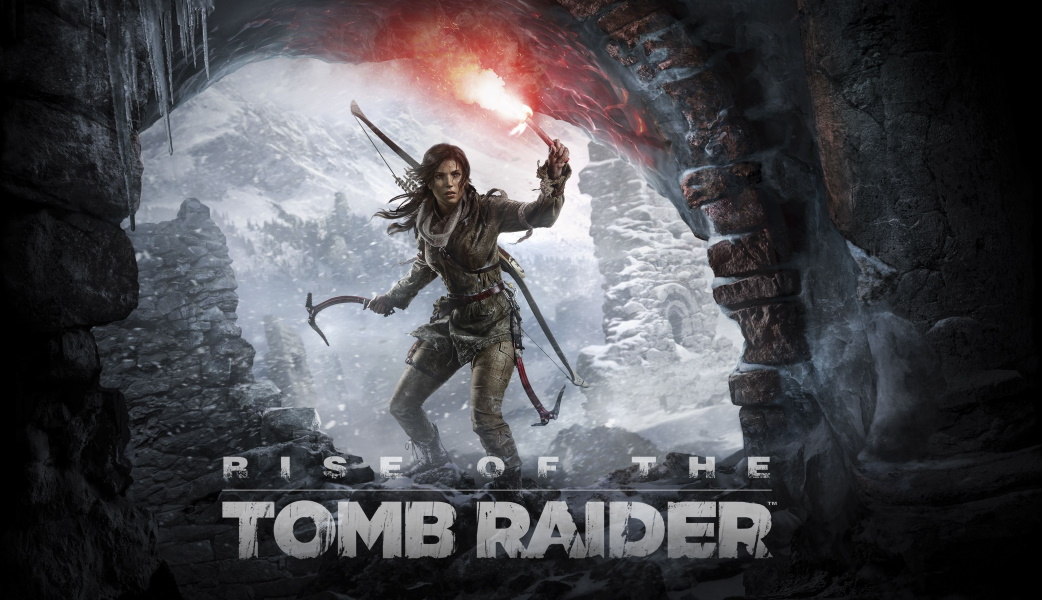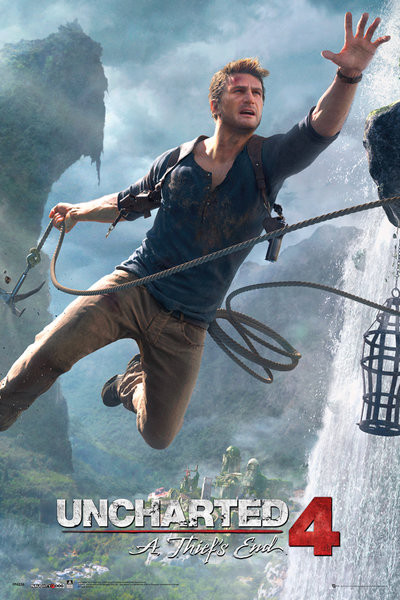Research Papers /
ENGL102 - Visual Analysis Paper (Twin Adventurers) [3]
Diop P. Belgrave
Professor Rebecca Eggenschwiler
English 102
Twin Adventurers
PHOTO DESCRIPTIONS
The first image will be referred to as "Raider" and the second as "Thief."
Raider portrays Lara Croft just as she enters an ancient manmade cave. She is heavily equipped and ready to find treasure.
Thief portrays Nathan Drake, suspended over 50 kilometers above the ground, grappling hook in hand, ready to swing to safety. There is a running waterfall to his immediate right, mountain range in the far distance, the ancient remains of a civilization far below in the background, and a menacing looking mountain to his left in the background - it looks like a shark's mouth.
Must two archetypically similar games in the Action Adventure genre share the same definition of the word "adventure"? Not necessarily. Both of the images are from blockbuster action adventure games. Rise of the Tomb Raider is the second game in the reimagined Tomb Raider series, and stars Lara Croft, a clever, brutal and courageous woman with a thirst for adventure; Uncharted 4: A Thief's End is the fourth and final installment in the critically acclaimed Uncharted series, and stars Nathan Drake, a quick-witted, jack-of-all-trades, veteran in the treasure hunting field. Although both games center around treasure hunting and raiding ancient tombs, they vary greatly in execution and message. Raider argues that adventure is about courage and fearlessness, while Thief argues that adventure is about survival and beating unsurmountable odds.
This is made first apparent in the settings of each image. Raider is set in a cold, dark and desolate environment, while Thief is set in a warm, vibrant, and flourishing one. While the only foliage visible in Raider is the greyed out evergreens in the distant background, Thief has no landmass without lively green vegetation. The absence of plant life in Raider makes its environment seem static and lifeless, which adds to the desolate atmosphere. Its entire setting is also depicted in greyscale, which is frequently used to portray fear and danger. Oppositely, Thief's generous use of vibrant colors, natural sunlight, and abundant foliage makes its environment appear more vivid and lively. Bold and vibrant colors are often used to depict positive situations and optimistic people. Thief then, creates a contrast between Drake's optimistic attitude and his immediate danger. This use of color subtly indicates a difference in how Lara and Drake feel about their situations.
Lara is very scared but also very courageous. Her eyes are focused and glaring, her face is slightly pale, her mouth is partly open with her teeth clenched, and her nostrils are flush, as if she has been holding her breath for a few seconds. All of these are common human fear and stress responses. Her courage, however, is expressed in her deliberate preparation for the trials ahead, and her overall posture. She has plenty of survival equipment including a longbow, quiver, holstered handgun, small satchel, two climbing picks, and a lit flare. As she holds the flare up to the cave with her left hand, she firmly grips one of the climbing picks with her right. She is prepared to use it as a melee weapon if necessary. Her feet are firmly planted and her lowered stance makes it harder to run away. Interestingly, although Drake is in much more danger than Lara, he looks calm.
Drake's attitude is one of confidence and fortitude. Unlike Lara, he has no expression of fear on his face or in his body language. His eyes are laser-focused on the off-screen grapple point, his whole body is angled towards it, his left hand is outstretched with conviction, and his right hand is cocked back to throw the grappling hook. Everything about his posture indicates self-assurance, as if he's done this many times before. Additionally, the fact that he only has one weapon, a holstered pistol, shows how strong he is. Unlike Lara who is fully equipped, Drake only needs one gun and a grappling hook to handle his business. The characters' physical appearances and clothing also add to the atmosphere of each picture.
Using a reddish flare as a main focal point in Raider helps portray Lara as the hero. The torch symbolizes light that will 'conquer the dark' that awaits her in the cave. The absence of her hat and gloves helps lend to her feminine depiction, showing her long hair delicate face. This paints Lara as a vulnerable human with fears and worries. The fact that most of her clothing is in sepia tones also creates a warm, comfortable vibe, similar to bare skin. In Thief Drake's shirt is navy blue, which is often associated with heroes. Even Drake's skin is vibrant, with reddish undertones, realistic shadowing, and moderate refraction of light on his right forearm and the right side of his neck. This 'divine-like' lighting also reinforces his heroism. The common heroic atmosphere makes it much easier for viewers to empathize with both Lara and Drake.
The titles of the two games also have implications of their purposes. Rise of the Tomb Raider is the foundation for, or "Rise of," Lara's story and character; Uncharted 4: A Thief's End is instead the end of Drake's story. Although both titles use faded lettering, Raider's title is reminiscent of a gritty paint or blood splatter, color shifted to black and white. This visual effect makes the words seem gloomy and scary. Contrarily, Thief's title looks like a whitened photocopy of an old map. This, and the idealized pirate cursive "A Thief's End" is written in, helps emphasize the ancient unexplored nature of Uncharted 4's environment. In Raider, Lara is shown at the entrance to a cave, just before starting her journey into it. Since the cave was manmade with ancient stonework, it could be categorized as a "Tomb" - hence "Rise of the Tomb Raider." In Thief, however, Drake is shown in a very exotic environment somewhere off the coast of Africa, in "Uncharted" territory. The fact that it is the fourth and final installment in the Uncharted series also indicates why Drake can be so calm in such a dangerous situation; he has been doing this for years. Lara has not had enough experience adventuring to be that calm. What becomes apparent is that Thief and Raider are referring to very similar situations but from different perspectives.
The contrast is a difference in depiction, not events. Lara is about to enter a cave alone, where nobody can hear her cry for help; this is objectively dangerous, and the whole atmosphere of the poster is that of a survival game or movie. Drake is clearly in a more dangerous situation, and must act immediately to survive, but there is a clear difference in tone. The audience can tell from the overall feel of the image that Drake will not die; it is not a question of "will he survive?" but "how will he survive?" Lara is portrayed with none of that security. Unlike Drake in Thief, both she and the viewer can imagine her dying. This is why Thief can portray a much deadlier situation in a less serious way.
In short, Raider creates the dichotomy of a cold and unforgiving world and humanly vulnerable protagonist to show that adventure is about exploring the unknown and facing one's fears; Thief oppositely, uses vibrant colors and an unflappable, resolute protagonist to nullify the magnitude of a death defying situation, and show that adventure is about confidently overcoming what to others is impossible. And Uncharted 4's oft-hurt-never-killed approach sold more copies.
Works Cited"RoTR PC Release." Idigitaltimes
"Uncharted 4 Poster." Merchandisingplaza

Raider

Thief


